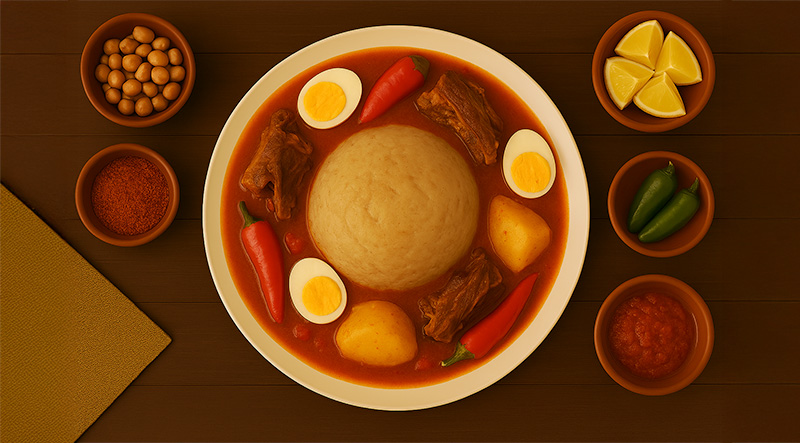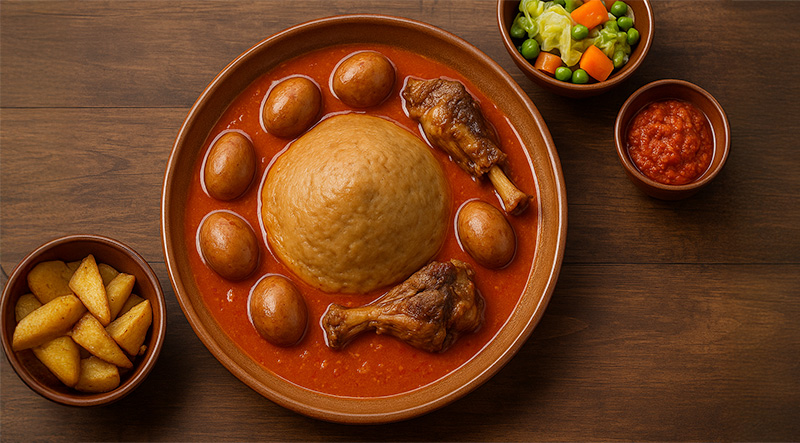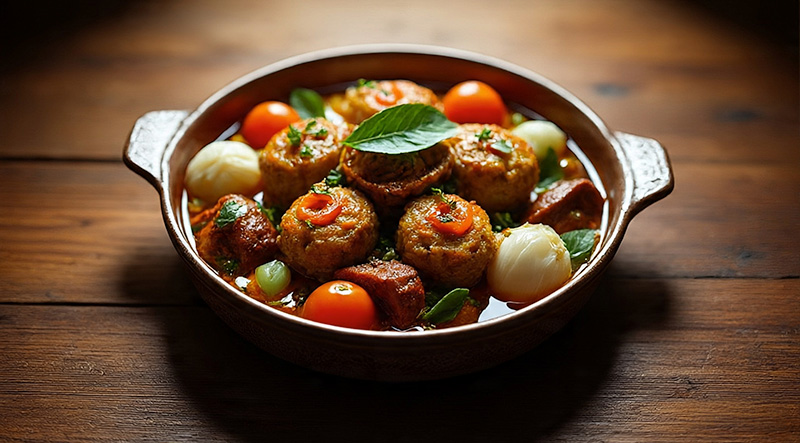Libya's culinary crown jewel is Bazin, a dish that unites families around a single steaming platter and is hearty, bold, and full of tradition. The rich flavors of a slow-simmered tomato stew full of tender meat, potatoes, and hard-boiled eggs are soaked up by the soft, springy mound of Bazin, which is made from dense, hand-kneaded barley dough. Bazin, which is shared and served without cutlery, is more than just a meal; it's a Libyan pride experience, with each bite narrating a tale of warm hospitality, desert origins, and long-standing custom. Read More...
The History of Libya’s National Dish – Bazin (Libyan Barley Dough with Meat Stew):
In the sun-soaked lands of North Africa, where nomadic traditions and Mediterranean influences blend seamlessly, Bazin stands as a culinary emblem of Libya’s cultural identity. This dense, hearty dish — made primarily from barley flour and served with a rich tomato-based stew — reflects centuries of survival, hospitality, and community that define Libyan life. Bazin is more than food; it’s a symbol of resilience and unity, passed down through generations from desert tents to modern kitchens.
Humble Origins in the Desert:
The origins of Bazin are rooted in the Berber and Bedouin cultures of Libya’s interior. In arid environments where wheat was scarce, barley flour became a staple — affordable, nourishing, and easy to store. The traditional method of preparing Bazin involved pouring boiling water over barley flour and skillfully kneading it with a wooden stick or spoon (mograf) until a stiff, elastic dough formed. This was then shaped into a dome or mound and placed at the center of a communal dish.
This technique not only maximized limited ingredients but also suited a nomadic lifestyle, where large, simple meals could feed entire families around a single plate. The inclusion of a hearty stew made with lamb, potatoes, and hard-boiled eggs added richness and sustenance, especially during religious celebrations and long days of labor.
Cultural and Religious Significance:
Bazin holds deep meaning in both daily life and ceremonial occasions. It is often prepared for Friday family meals, weddings, and Ramadan feasts. Its communal style of eating — typically with the right hand, using small pieces of dough to scoop up the stew — reinforces values of hospitality, humility, and togetherness.
In many Libyan households, the art of making Bazin is a generational ritual. Elders pass down not only the technique but also the cultural significance behind the dish. A well-made Bazin, with its smooth texture and perfect elasticity, is seen as a point of pride — a reflection of the cook’s patience, strength, and skill.
From Ancient Roots to Modern Tables:
While Bazin’s preparation remains traditional, the dish has also adapted to modern kitchens. Some use semolina or wheat flour for convenience, and pressure cookers have replaced slow stewing methods. Still, the essence of Bazin remains unchanged — it continues to represent Libya’s deep-rooted agricultural traditions and its people’s ability to nourish and connect despite environmental and political challenges.
In Libya’s diaspora communities, Bazin serves as a comforting reminder of home — a way to stay connected to roots, customs, and family over a shared meal. It’s often featured during national holidays and cultural showcases, earning recognition not just as a dish, but as a symbol of Libyan heritage.
A Dish That Tells a Story:
The history of Bazin is, at its core, the story of resourcefulness, community, and pride. From desert encampments to city homes, it has nourished Libyan families for generations and continues to do so with each flavorful, hand-shaped bite. It’s not just Libya’s national dish — it’s a warm, resilient expression of who the Libyan people are.
Prepare the Stew:

Make the Bazin Dough:

Serve:

Tips & Notes:
The total preparation and cooking time for Bazin with meat stew is approximately 1 hour and 20 minutes. Prepping the ingredients — including chopping onions, peeling potatoes, and boiling eggs — takes about 15–20 minutes. Simmering the meat stew until tender requires 45–60 minutes, depending on the cut and size of the meat. While the stew is cooking, preparing the Bazin dough takes an additional 15–20 minutes, involving boiling water, mixing, and kneading the barley flour into a smooth, elastic mound. With some multitasking, the entire dish can be completed in just over an hour, making it both a traditional and achievable Libyan meal.
A single serving of Bazin with meat stew, based on the traditional recipe provided, contains approximately 500–650 calories. The barley flour dough (about 1 cup cooked per serving) provides roughly 200–250 calories, mainly from complex carbohydrates and some fiber. The meat stew—including lamb or beef, potatoes, tomato paste, and oil—adds about 300–400 calories, depending on the fat content of the meat and the amount of oil used. Additional calories may come from optional boiled eggs (about 70–80 calories each) or garnish. Despite its simplicity, Bazin is a nutrient-dense, energy-packed meal traditionally designed to sustain and satisfy.







